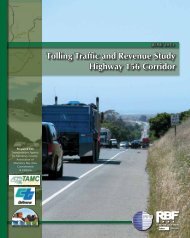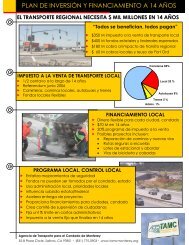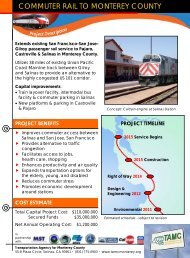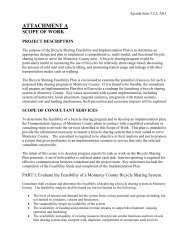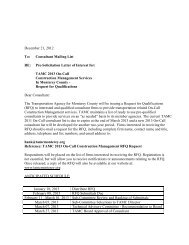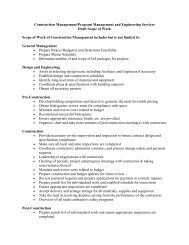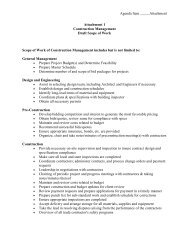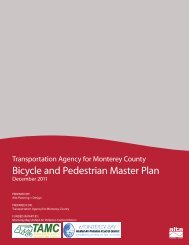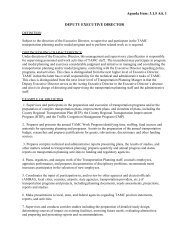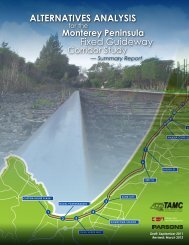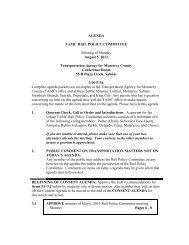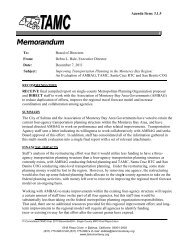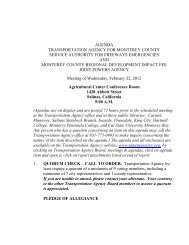Commuter Rail Extension Alternatives Analysis - Transportation ...
Commuter Rail Extension Alternatives Analysis - Transportation ...
Commuter Rail Extension Alternatives Analysis - Transportation ...
You also want an ePaper? Increase the reach of your titles
YUMPU automatically turns print PDFs into web optimized ePapers that Google loves.
CALTRAIN EXTENSION TO MONTEREY COUNTYALTERNATIVES ANALYSISAt the time that the Monterey County Housing Element was prepared (2003), the 2000 U.S. Censusdata regarding household income according to the income categories of lower, moderate and abovemoderate was not yet available. Based on 1990 U.S. Census Data for the County of Monterey (unincorporatedand incorporated areas), approximately 22 percent of all households could be consideredvery low income and another 19 percent of households as low income.The State of California, Department of Finance, has estimated that there were 34,762 households asof January 1, 2002 in the unincorporated areas of Monterey County. The chart below demonstratesthe estimated number of households by income category using the 1990 household incomepercentage distributions as applied to the 2002 Department of Finance household estimates.HouseholdIncome:VeryLowLowModerateAboveModerateUnincorporatedArea TotalNumber of Households 7,648 6,605 8,690 11,819 34,762(Percentage of Total) 22% 19% 25% 34% 100%645188AA-097Information provided in the Housing Element (Monterey County, 2003) indicates that the two majorindustries in Monterey County are tourism and agriculture. The average annual wage in the“agricultural industry cluster” in Monterey County is approximately $18,608, which is considered verylow income for households of two persons or more. Tourism related jobs also pay very low wages.Households with members who rely on employment in either or both of these fields could beexpected to qualify as either very low or low income, depending on household size.SalinasThe 1990 U.S. Census indicates that 49.85 percent of Salinas’ population is of low and moderateincome. The city of Salinas’ economy is predominantly agriculturally oriented, with relatively lowskilled,low-paying jobs (City of Salinas, 2002).Figure 8-5 illustrates the distribution of population by block group above and below income povertylevels according to the 2000 census. The graphic illustrates concentrations of lower income familieswhich would be served by the proposed transit investment.Similar to the assessment of household population served by the Caltrain <strong>Extension</strong> <strong>Alternatives</strong>tations located in Monterey County, a tabulation of jobs within easy access of existing Caltrainstations was undertaken. Buffers of 0.5-mile, 1-mile, and 2-mile radii were drawn around each of theCaltrain stations located within Santa Clara County. Data from surveys of Caltrain and Altamont<strong>Commuter</strong> Express (ACE) riders indicate that existing riders of commuter rail travel to jobs wellbeyond the 0.5-mile radius typically assumed by Federal Transit Administration (FTA) for its “NewStarts” mobility criteria. In Santa Clara County, the presence of shuttle bus service provided by majoremployers and the VTA greatly increases the accessibility of these commuter rail stations to jobs.Figures 8-6 and 8-7 illustrate the commuter rail station locations and accessibility buffers within SantaClara County. Figure 8-6 includes an ACE station at the Great America theme park within the city ofSanta Clara for reference.Table 8-39 presents a tabulation of jobs accessible to Caltrain stations. Caltrain provides transitaccess to 572,737 jobs within Santa Clara County as of Year 2000 estimates. Jobs in San Mateo andSan Francisco counties would be in addition. Please note that the tabulation of jobs served by thestations excludes double counting due to overlaps of the buffers.parsons CHAPTER 8: EVALUATION OF ALTERNATIVES 206



